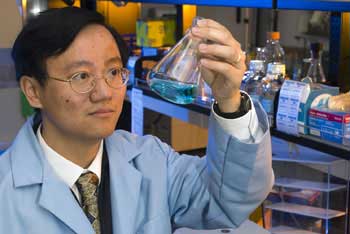Air Force funded researcher engineers enzymes to advance the hydrogen economy

Y. H. Percival Zhang, assistant professor of biological systems engineering at Virginia Tech, has received an Air Force Young Investigator award to advance development of an onboard process to convert a cellulosic material into hydrogen to power fuel cell vehicles.
Zhang and colleagues Barbara R. Evans and Jonathan R. Mielenz of Oak Ridge National Laboratory and Robert C. Hopkins and Michael W.W. Adams of the University of Georgia have previously demonstrated that they can use a combination of 13 enzymes never found together in nature to completely convert polysaccharides (C6H10O5) in a starch-like powder form and water into hydrogen (PLOS ONE May 23, 2007). “The enzymes use the energy in the starch to break up water into only carbon dioxide and hydrogen,” Zhang said.
In the Air Force-funded research, Zhang will engineer enzymes to expedite the conversion of the insoluble cellulosic substrate into the soluble product that is ultimately converted to hydrogen energy – to effect a phase change from solid to liquid. “It is a rate-limiting step in the process and our research will speed up the reaction rate,” said Zhang.
“How fast the reaction happens is an important consideration because you don’t want to wait in your vehicle while the product of a biochemical process feeds your fuel cell,” said Zhang.
There is a newly-discovered enzyme that converts cellulose to glucose 1-phosphate (G-1-P); this enzyme will be engineered to speed up the process. The critical step is the conversion of G-1-P to glucose 6-phosphate (G-6-P) – the energy source for many living systems that a subsequent enzyme team will convert to hydrogen for the fuel cell, as previously demonstrated.
The process can stall at G-1-P, but Zhang has a plan for creating a special enzyme that converts the material from G-1-P to G-6-P so quickly there is hardly a pause at all.
“This novel enzymatic carbohydrate-to-hydrogen conversion has reached an exceedingly high hydrogen storage density, so that 1 kilogram of sugar will release 0.148 kilogram of hydrogen, and hydrogen release from the carbohydrate can be implemented at modest biochemical reaction conditions, such as 140 degrees F, and normal pressure,” he said.
“Energy storage is important for transportation applications because you don’t want the fuel tank to take up a lot of space.”
The Air Force Office of Scientific Research will award approximately $9.5 million in grants to 29 scientists and engineers who submitted winning research proposals through the Air Force's Young Investigator Research Program. The program is open to scientists and engineers at research institutions across the United States. Those selected will receive the grants over a three-year period. A total of 215 proposals were received in response to the solicitation in major areas of interests to the Air Force. Interest areas include: aerospace, chemical and material sciences; mathematics, information and life sciences; and physics and electronics. The program supports scientists and engineers who have received Ph.D. or equivalent degrees in the last five years.
Grant recipients must show exceptional ability and promise for conducting basic research. The objective of this program is to foster creative basic research in science and engineering, enhance early career development of outstanding young investigators, and increase opportunities for the young investigators to recognize the Air Force mission and the related challenges in science and engineering.
Zhang’s basic research will help characterize the cellulose phosphorylation cleavage at the surface of cellulose, understand the kinetics and mechanisms of the reaction, and promote development of future carbohydrate-hydrogen fuel cell power systems. He is also developing one graduate level course on enzyme engineering, supporting Ph.D. students, and providing opportunities for undergraduate research. Zhang is also a participant in the U.S. Department of Energy ORNL-led Bioenergy Research Center and collaborates with other DOE labs, universities, companies, and military labs.




